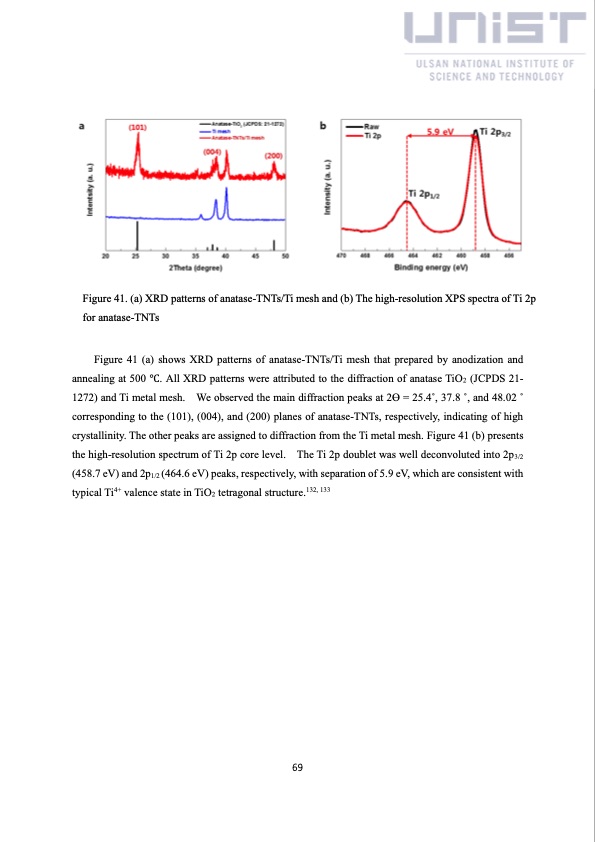
PDF Publication Title:
Text from PDF Page: 074
Figure 41. (a) XRD patterns of anatase-TNTs/Ti mesh and (b) The high-resolution XPS spectra of Ti 2p for anatase-TNTs Figure 41 (a) shows XRD patterns of anatase-TNTs/Ti mesh that prepared by anodization and annealing at 500 °C. All XRD patterns were attributed to the diffraction of anatase TiO2 (JCPDS 21- 1272) and Ti metal mesh. We observed the main diffraction peaks at 2Ɵ = 25.4 ̊, 37.8 ̊, and 48.02 ̊ corresponding to the (101), (004), and (200) planes of anatase-TNTs, respectively, indicating of high crystallinity. The other peaks are assigned to diffraction from the Ti metal mesh. Figure 41 (b) presents the high-resolution spectrum of Ti 2p core level. The Ti 2p doublet was well deconvoluted into 2p3/2 (458.7 eV) and 2p1/2 (464.6 eV) peaks, respectively, with separation of 5.9 eV, which are consistent with typical Ti4+ valence state in TiO2 tetragonal structure.132, 133 69PDF Image | China solar seawater battery

PDF Search Title:
China solar seawater batteryOriginal File Name Searched:
solar-seawater.pdfDIY PDF Search: Google It | Yahoo | Bing
Product and Development Focus for Salgenx
Redox Flow Battery Technology: With the advent of the new USA tax credits for producing and selling batteries ($35/kW) we are focussing on a simple flow battery using shipping containers as the modular electrolyte storage units with tax credits up to $140,000 per system. Our main focus is on the salt battery. This battery can be used for both thermal and electrical storage applications. We call it the Cogeneration Battery or Cogen Battery. One project is converting salt (brine) based water conditioners to simultaneously produce power. In addition, there are many opportunities to extract Lithium from brine (salt lakes, groundwater, and producer water).Salt water or brine are huge sources for lithium. Most of the worlds lithium is acquired from a brine source. It's even in seawater in a low concentration. Brine is also a byproduct of huge powerplants, which can now use that as an electrolyte and a huge flow battery (which allows storage at the source).We welcome any business and equipment inquiries, as well as licensing our flow battery manufacturing.| CONTACT TEL: 608-238-6001 Email: greg@salgenx.com | RSS | AMP |